Gardner M. Sixth Book of Mathematical Diversions from Scientific American
Подождите немного. Документ загружается.

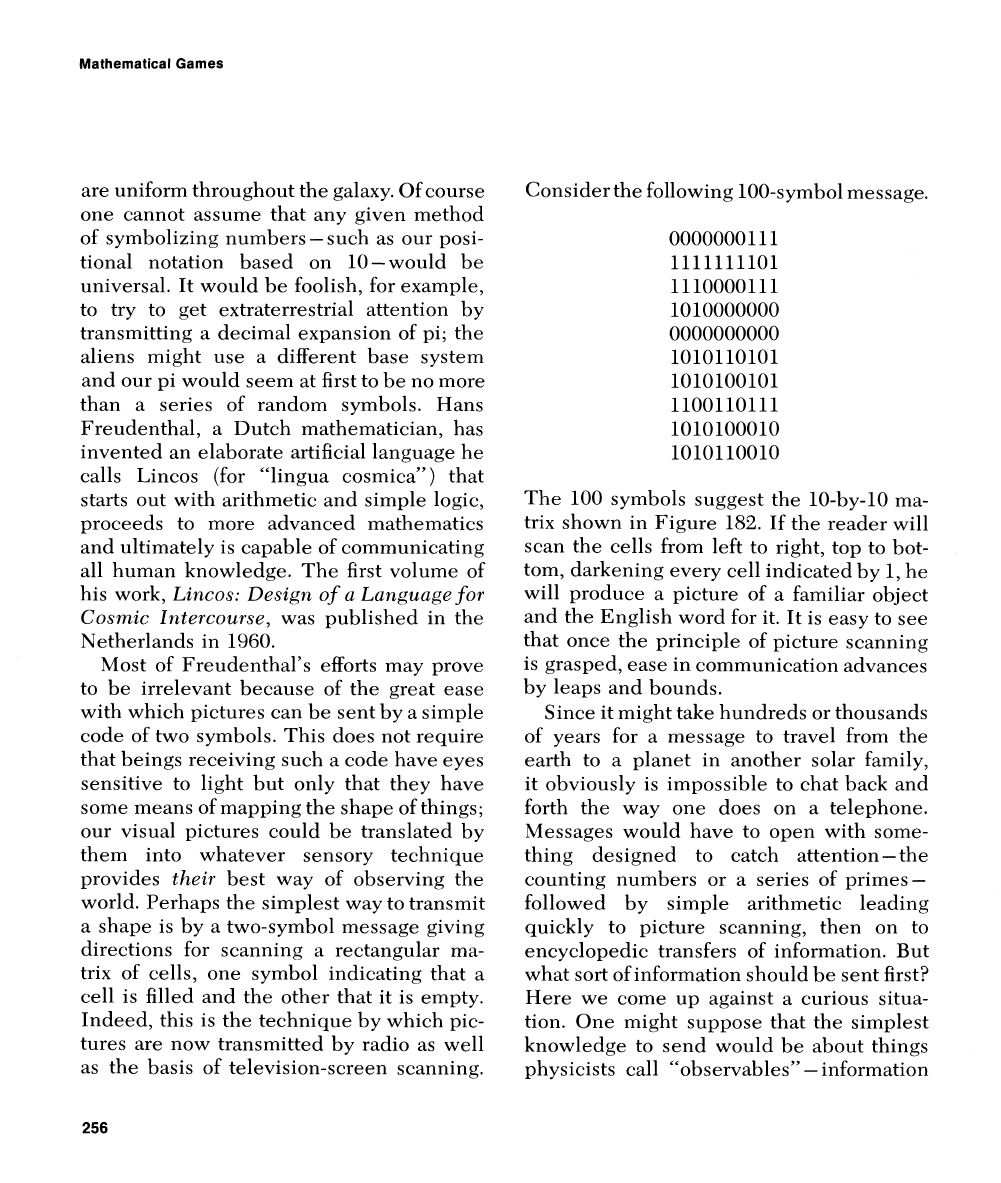
Mathematical Games
are uniform throughout the galaxy. Of course
one cannot assume that any given method
of symbolizing
numt~ers
-
such as our posi-
tional notation based
on 10 -would be
universal. It would be foolish, for example,
to try to get extraterrestrial attention by
transmitting a decimal expansion of pi; the
aliens might use a different base system
and our pi would seem at first to be no more
than a series of random symbols. Hans
Freudenthal,
a
Dutch mathematician, has
invented an elaborate artificial language he
calls Lincos (for "lingua cosmica") that
starts out with arithmetic and simple logic,
proceeds to more advanced mathematics
and ultimately is capable of communicating
all human knowledge. The first volume of
his work,
Lincos: Design
of
u
Language
for
Cosmic
Intercoz~rse,
was published in the
Ketherlands in 1960.
Most of Freudenthal's efforts may prove
to be irrelevant because of the great ease
with which pictures can be sent by a simple
code of two symbols. This does not require
that beings receiving such a code have eyes
sensitive to light but only that they have
some means of mapping the shape of things;
our visual pictures could be translated by
them into whatever sensory technique
provides
their
best way of observing the
world. Perhaps the simplest way to transmit
a shape is by a two-symbol message giving
directions for scanning a rectangular ma-
trix of cells, one symbol indicating that a
cell is filled and the other that it is empty.
Indeed, this is the technique by which pic-
tures are now transmitted
by radio as well
as the basis of television-screen scanning.
Consider the following 100-symbol message.
The 100 symbols suggest the 10-by-10 ma-
trix shown in Figure
182.
If the reader will
scan the cells from left to right, top to bot-
tom, darkening every cell indicated
by 1, he
will produce a picture of a familiar object
and the English word for it. It is easy to see
that once the principle of picture scanning
is grasped, ease in communication advances
by leaps and bounds.
Since it might take hundreds or thousands
of years for a message to travel from the
earth to a planet in another solar family,
it obviously is impossible to chat back and
forth the way one does on a telephone.
hlessages would have to open with some-
thing designed to catch attention
-
the
counting numbers or a series of
primes-
followed by simple arithmetic leading
quickly to picture scanning, then on to
encyclopedic transfers of information. But
what sort of information should be sent first?
Here we come up against a curious situa-
tion. One might suppose that
the
simplest
knowledge to send would be about things
physicists call "observables"
-
information

Extraterrestrial Communication
182. 10-by-10 scanning matrix
derived from our senses, often aided by
relatively simple observational devices such
as telescopes and microscopes. But suppose
the minds on Planet
X
have as their most
highly developed sense some method of
mapping the world that evolution here
has failed to exploit, say by magnetic forces
or some type of radiation not yet known to
us. Our pictures of the world, derived from
our observables, might have less meaning
on Planet
X
than information about such
"unobservables" as electrons, protons and
neutrons. If so,
the inhabitants of Planet
X
might understand a description of the peri-
odic table of elements
more readily than
a
description of
a
house or tree. From one
point of view the colors, shapes and sounds
of our world are the bedrock facts and the
electron a shadowy abstraction. The prob-
lems arising here suggest the opposite. The
mathematical structure of a helium atom
may be
more uni\,ersally understood than
the color, smell, taste and shape of an apple,
not just because apples are unlikely to grow
on other planets but because other minds
may map their worlds with senses
that have
little in
common with sight, smell, taste
and touch. Inferred entities such as particles
and electromagnetic fields might be easier
for extraterrestrials to understand than the
familiar sights and sounds of our world.
In
1960
Ivan Bell, an Englishman teach-
ing English in Tokyo, read about the plans
for Project Ozina. To
amuse his friends he
devised a simple interplanetary message
of
24
symbols. It was printed in
The
Japan
Tintes
of January
22,
1960,
and readers
were asked if they could decipher it. Four
complete solutions were received. One
was from hlrs. Richard T. Field, now living
in Bridgeton, New Jersey, who
sent me a
photocopy of Bell's article.
Bell's message is reproduced in Figure
183.
It is much easier to decipher than it
looks, and readers are urged to try it. Let-
ters
fro111
A
through
Z
(omitting
0
and
X)
provide the
24
symbols. (Each symbol is
presumably radioed
by a combination of
beeps, but we need not be concerned with
those details.) The punctuation marks are
not part of the message but indications of
time lapses. Adjacent letters are sent with
short pauses between them.
A
space be-
tween letters means a longer
pause Com-
mas, semicolons, and periods represent
progressively longer pauses. The loilgest
time lapses come between paragraphs,
wl~ich are numbered for the reader's con-
venience; the
numbers are not part of the

Mathematical Games
1.
A.3.C D
E.F.G.Y.1.d.K.-M.N.PQ.P.S.T.U.V.W.Y.Z.
---
--
2.
CA,B;AAC,C,ACCA,D,PCAAA,E;APPPPA,F,kPLPkCC,G;
AAACPAAA,H;PAAAAACAA.l;ALiACAAAPAA,,.
-
3.
AKA-B,PKCKALC;AKAYAYALD AKA-B;BKALC;CKkLD;
DYALE
BKELG,G-EYB.FKD-J;JLFKD.
4.
CMGLB,DMA-C,MCLB.
12.
ULWP;UPBLWB;AWDMALWDLDPU.VLWNA;VPCLWNC.
V
Q
d
L
WNNA;
V
Q
S
L WNNNA.
J
P
EWFGY
I
EFWGY;
S
P
EWFGH L EFCWH.
13.
GIWH
Y
HN;
T
K C
Y
T.
Z
Y
CWADAF.
183. Ivan Beli's interplanetary message
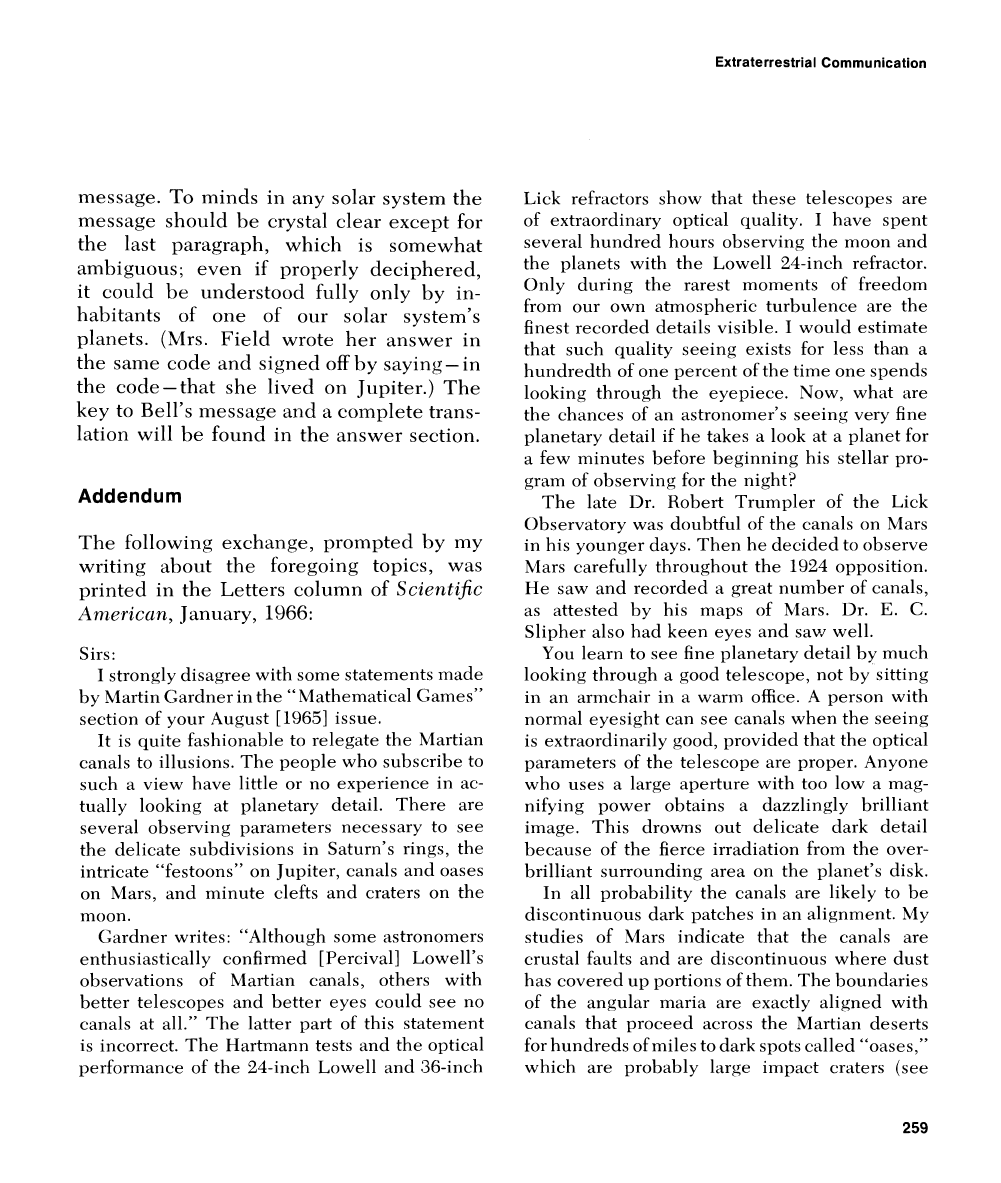
Extraterrestrial Communication
message. To minds in any solar system the
message should
1)e crystal clear except for
the last
paragraph, which is somewhat
ambiguous; even if properly deciphered,
it could
be
understood fully only
by
in-
habitants of one of our solar system's
planets. (hlrs. Field wrote her answer in
the
same code and signed off by saying-in
the
code-that she lived on Jupiter.) The
key to Bell's
message and
a
complete trans-
lation
will
be
found in the answer section.
Addendum
The following exchange, prompted by my
writing about the foregoing topics, was
printed in the Letters column of
Scier~tific
American,
January,
1966:
Sirs:
I strongly disagree with
some statenierlts made
by
hfartin Gardner in the "llathematical Games"
section of your August
[1965]
issue.
It is quite fashionable to relegate the
RIartian
canals to illusions. The people who subscribe to
such
a
view have little or no experience in ac-
tually looking at planetary detail. There are
several observing parameters necessary to see
the delicate subdivisions
ir~ Saturn's rings, the
intricate
"festootls" on Jupiter, canals and oases
on Mars, and minute clefts and craters on the
moon.
Cardner writes: "rilthough some astro~lomers
enthusiastically confirmed [Percival] Lowell's
observations of
llartian canals, others with
better telescopes and better eyes could see no
canals at all." The latter part of this
state~nent
is incorrect. The Hartmann tests and the optical
performance
of
the 24-inch Lowell and 36-inch
Lick refractors show that these telescopes are
of extraordinary optical quality.
I
have spent
several
hundred hours observing the moon and
the planets with the Lowell 24-inch refractor.
Only during the rarest
nlome~lts of freedom
from our own atmospheric turbulence are the
finest recorded details visible. I would
estimate
that such quality seeing exists for less t11;ul a
hundredth of one percent of the time one spends
looking through the eyepiece. Now, what are
the
chalices
of an astronomer's seeing very fine
planetary detail if he takes a look at a planet for
a few
minutes before beginning his stellar pro-
gram of observing for the night?
The late Dr. Robert
Truln~ler of the Lick
Obselvatorv
was
doubtful of the canals on llars
in his younger days. Theri he decided to observe
llars carefully throughout the
1924
opposition.
He saw and recorded a great
riunlber of canals,
as attested by his
niaps of llars. Dr.
E.
C.
Slipher also had keen eyes and saw well.
You learn to see fine planetary detail
115; much
looking through a good telescope,
not by sitting
in an armchair in a warm office.
A
Derson with
normal eyesight
call see canals when the seeing
is extraordinarily good, provided that the optical
parameters of the telescope are proper.
Anyorle
who uses a large aperture with too low a mag-
nifying power obtains a dazzlingly brilliant
image. This drowns out delicate dark detail
because of the fierce irradiation from the
over-
brilliant surrounding area on the planet's disk.
In all probability the callals are likely to be
discontinuous dark patches in an alignment.
hly
studies of llars indicate that the callals are
crustal faults arid are
discontil~uous where dust
has
covered up portions of them. The boundaries
of the angular maria are exactly aligned with
canals that proceed across the Martian deserts
for
hundreds of miles to dark sl~ots called "oases,"
which are probably large
impact craters (see
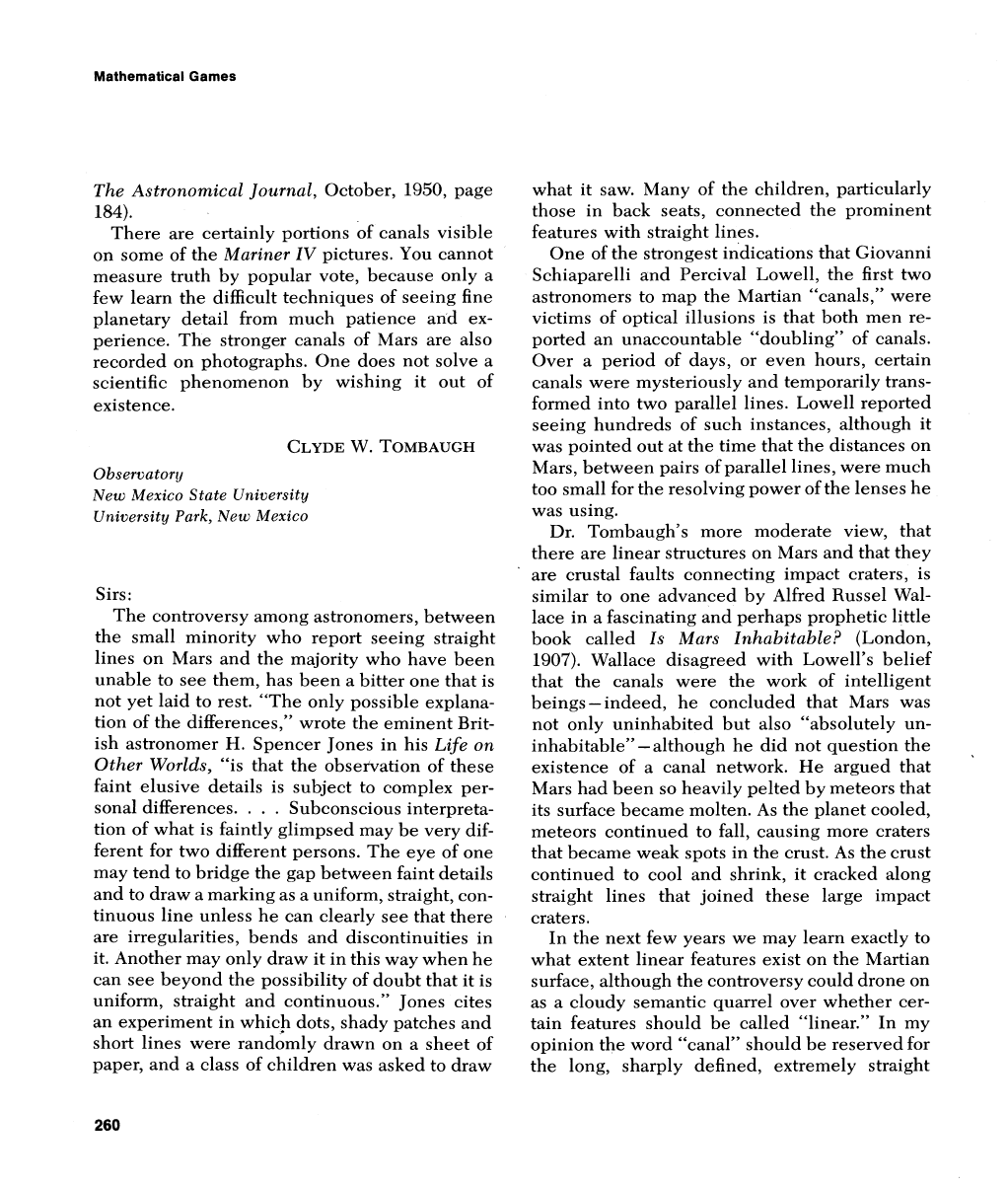
Mathematical Games
The Astronomical Journal,
October, 1950, page
184).
There are certainly portions of canals visible
on some of the
Mariner
IV
pictures. You cannot
measure truth by popular vote, because only a
few learn the difficult techniques of seeing fine
planetary detail from much patience and ex-
perience. The stronger canals of Mars are also
recorded on photographs. One does not solve a
scientific phenomenon by wishing it out of
existence.
Obsercatory
Neu Mexico State Uniaersity
Uniaersity Park,
Kew Alexico
Sirs:
The controversy among astronomers, between
the small minority who report seeing straight
lines on Mars and the majority who have been
unable to see them, has been a bitter one that is
not yet laid to rest. "The only possible explana-
tion of the differences," wrote the eminent Brit-
ish astronomer H. Spencer Jones in his
Life
on
Other Worlds,
"is that the observation of these
faint elusive details is subject to complex per-
sonal differences.
.
. .
Subconscious interpreta-
tion of what is faintly glimpsed may be very dif-
ferent for two different persons. The eye of one
may tend to bridge the gap between faint details
and to draw a marking as a uniform, straight, con-
tinuous line unless he can clearly see that there
are irregularities, bends and discontinuities in
it. Another may only draw it in this way when he
can see beyond the possibility of doubt that it is
uniform, straight and continuous." Jones cites
an experiment in which dots, shady patches and
short lines were randomly drawn on a sheet of
paper, and a class of children was asked to draw
what it saw. Many of the children, particularly
those in back seats, connected the prominent
features with straight lines.
One of the strongest indications that Giovanni
Schiaparelli and Percival Lowell, the first two
astronomers to map the Martian "canals," were
victims of optical illusions is that both men re-
ported an unaccountable "doubling" of canals.
Over a period of days, or even hours, certain
canals were mysteriously and temporarily trans-
formed into two parallel lines. Lowell reported
seeing hundreds of such instances, although it
was pointed out at the time that the distances on
Mars, between pairs of parallel lines, were much
too small for the resolving power of the lenses he
was using.
Dr. Tombaugh's more moderate view, that
there are linear structures on Mars and that they
are crustal faults connecting impact craters, is
similar to one advanced by Alfred Russel Wal-
lace in a fascinating and perhaps prophetic little
book called
Is lZrlars Inhabitable?
(London,
1907). Wallace disagreed with Lowell's belief
that the canals were the work of intelligent
beings
-
indeed, he concluded that Mars was
not only uninhabited but also "absolutely un-
inhabitable"
-
although he did not question the
existence of a canal network. He argued that
Mars had been so heavily pelted by meteors that
its surface became molten. As the planet cooled,
meteors continued to fall, causing more craters
that
became weak spots in the crust. As the crust
continued to cool and shrink, it cracked along
straight lines that joined these large impact
craters.
In the next few years we may learn exactly to
what extent linear features exist on the Martian
surface, although the controversy could drone on
as a cloudy semantic quarrel over whether cer-
tain features should be called "linear." In my
opinion the word "canal" should be reserved for
the long, sharply defined, extremely straight
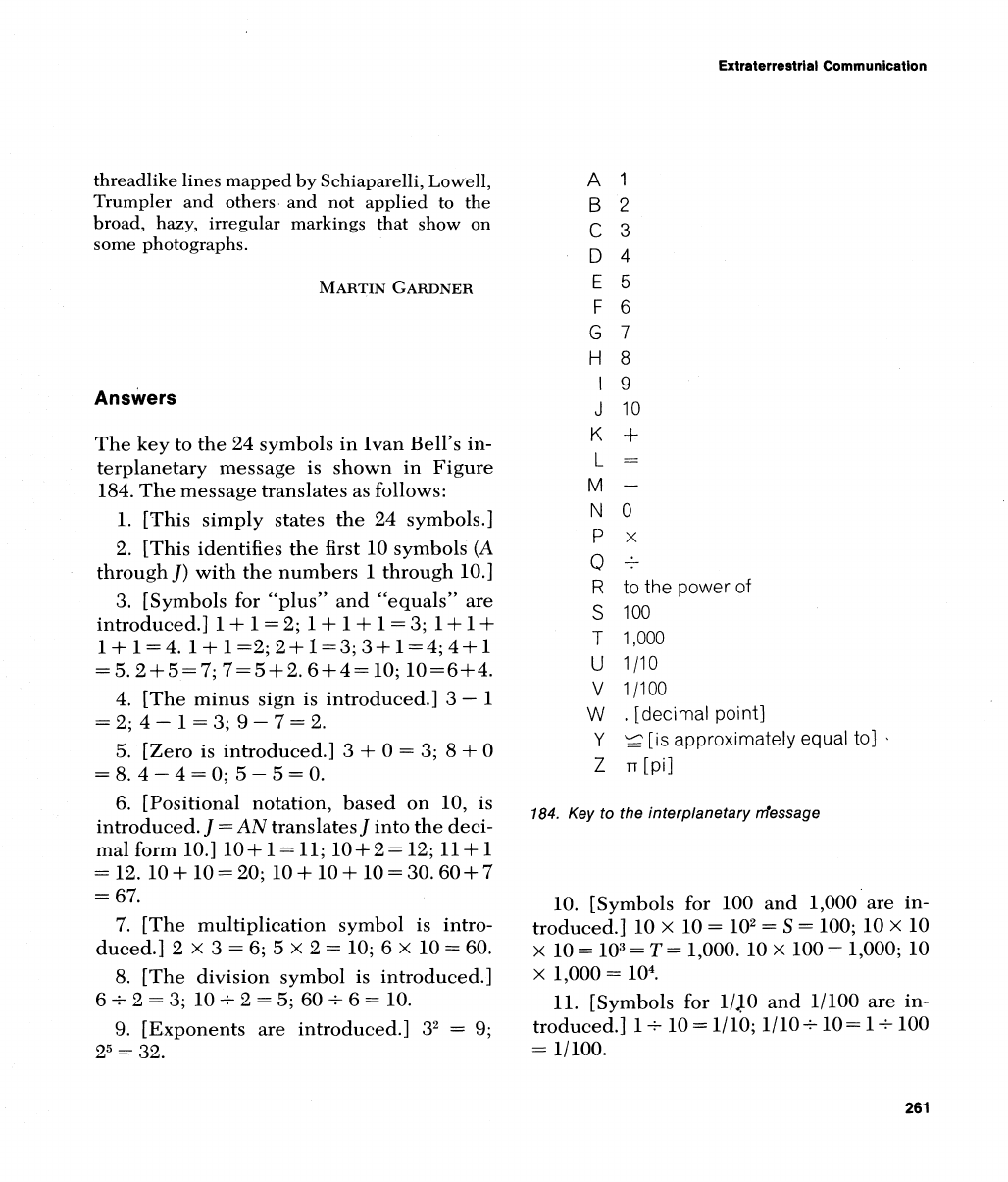
Extraterrestrial
Communication
threadlike lines mapped by Schiaparelli, Lowell,
Trumpler and others and not applied to the
broad, hazy, irregular markings that show on
some photographs.
Answers
The key to the
24
symbols in Ivan Bell's in-
terplanetary message is shown in Figure
184.
The message translates as follows:
1.
[This simply states the
24
symbols.]
2.
[This identifies the first
10
symbols
(A
through
J)
with the numbers
1
through
10.1
3.
[Symbols for "plus" and "equals" are
introduced.]
1
+
1
=
2;
1
+
1
+
1
=
3;
1
+
1
+
1+1=4.1+1=2;2+1=3;3+1=4;4+1
=5.2+5=7; 7=5+2.6+4=10; 10=6+4.
4.
[The minus sign is introduced.]
3
-
1
=2; 4- 1=3; 9-7=2.
5.
[Zero is introduced.]
3
+
0
=
3; 8
+
0
=8.4-4=0; 5-5=0.
6.
[Positional notation, based on
10,
is
introduced.
J
=AN
translates] into the deci-
malform
10.1 10+1=11; 10+2=12;
ll+1
=
12. 10+ 10=20; 10+ 10+ 10=30.60+7
=
67.
7.
[The multiplication symbol is intro-
duced.]
2
x
3
=
6; 5
x
2
=
10; 6
x
10
=
60.
8.
[The division symbol is introduced.]
6+2=3; 10+2=5; 60+6=10.
9.
[Exponents are introduced.]
=
9;
25
=
32.
G
7
H
8
19
J
10
K
+
L
=
M
-
N
0
P
x
Q
+
R
to the power of
S
100
T
1,000
u
1/10
v
I/lOO
W
.
[decimal point]
Y
r
[is
approximately equal to]
%
z
[pi1
184.
Key to the interplanetary dessage
10.
[Symbols for
100
and
1,000
are in-
troduced.]
10
x
10
=
102
=
S
=
100; 10
X
10
x
10
=
10"
T
=
1,000. 10
x
100
=
1,000; 10
x
1,000
=
lo4.
11.
[Symbols for
1/10
and
11100
are in-
troduced.]
1
t
10
=
1/10; 1/10
+-
10=
1
+
100
=
11100.
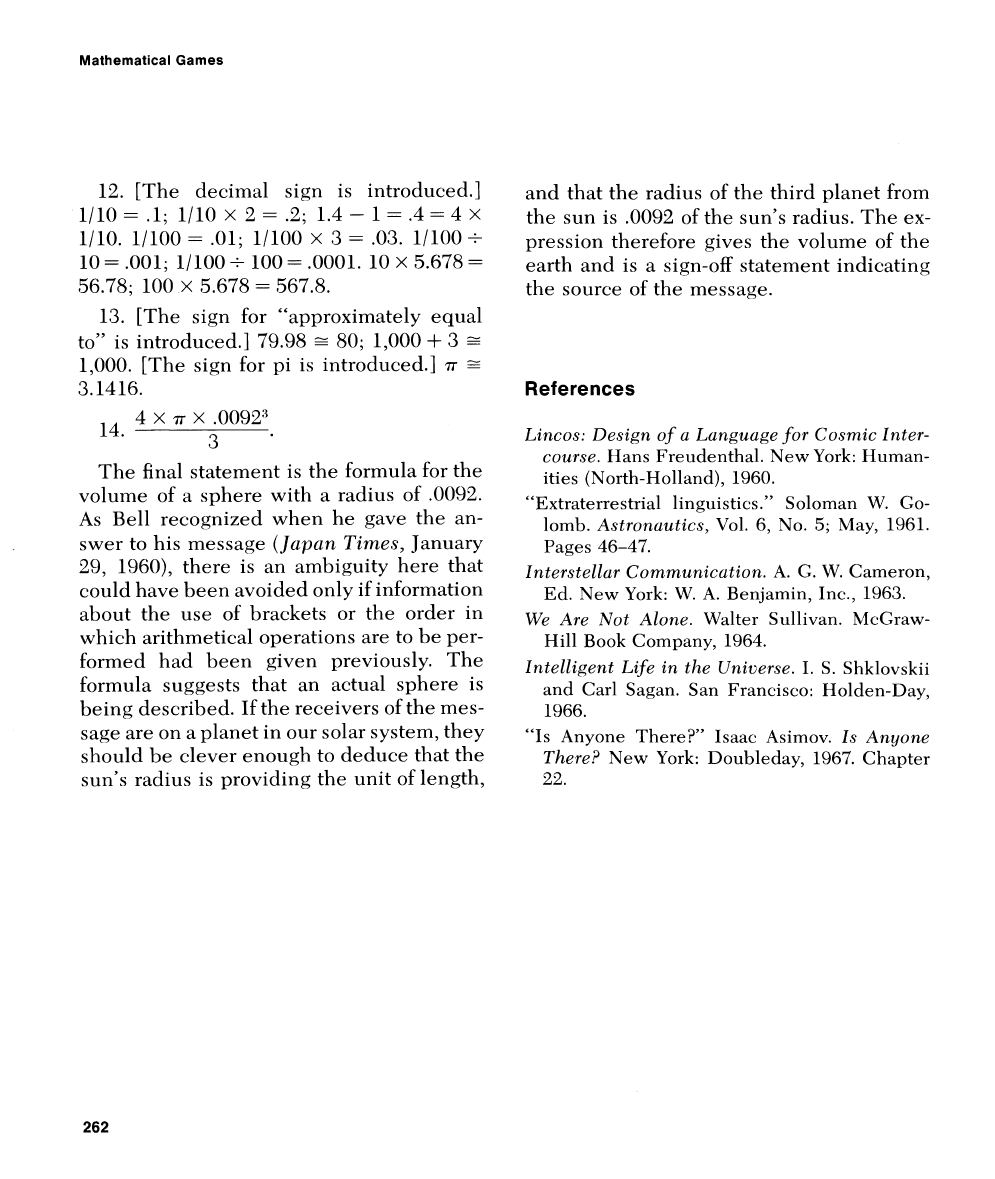
Mathematical Games
12.
[The deci~nal sign is introduced.]
1/10
=
.1;
1/10
X
2
=
.S; 1.4
-
1
=
.4
=
4
X
1/10. 1/100
=
.01; 1/100
x
3
=
.03. 11100
+
10
=
.001; 11100
+
100
=
.0001. 10
x
5.678
=
rj6.78; 100
X
3.678
=
567.8.
13.
[The sign for "approximately equal
to" is introduced.]
79.98
=
80; 1,000
+
3
z
1,000.
[The sign for pi is introduced.]
.ir
z
3.1416.
The final statement is the formula for the
volume of a sphere with a radius of
,0092.
As Bell recognized when he gave the an-
swer to his message
(Japan
Times,
January
29, 1960),
there is an ambiguity here that
could have been avoided
only if information
about the use of brackets or the order in
which arithmetical operations are to be per-
formed had been given previously. The
formula suggests that an actual sphere is
being described. If the receivers of the mes-
sage are on a planet in our solar system, they
should be clever enough to deduce that the
sun's radius is providing the unit of length,
and that the radius of the third planet from
the sun is
.0092
of the sun's radius. The ex-
pression therefore gives the volume of the
earth and is a sign-off statement indicating
the source of the message.
References
Lincos: Design of a Language for Cosmic Inter-
course.
Hans Freudenthal. New York: Human-
ities (North-Holland), 1960.
"Extraterrestrial linguistics."
Soloman
W.
Go-
lomb.
Astronautics,
Vol. 6, No.
5;
Slay, 1961.
Pages 46-47.
Interstellar Communication.
A.
6.
W.
Cameron,
Ed. New York:
\V.
A.
Benjamin, Inc., 1963.
\lie
Are Not Alone.
Walter Sullivan. YlcGraw-
Hill Book Company, 1964.
Intelligent Life in the Uni~erse.
I.
S. Shklovskii
and Carl
Sagan. San Francisco: Holden-Day,
1966.
"Is
Anyo~le There?" Isaac Asimov.
Is
Anyone
There.?
New York: Doubleday, 1967. Chapter
22.
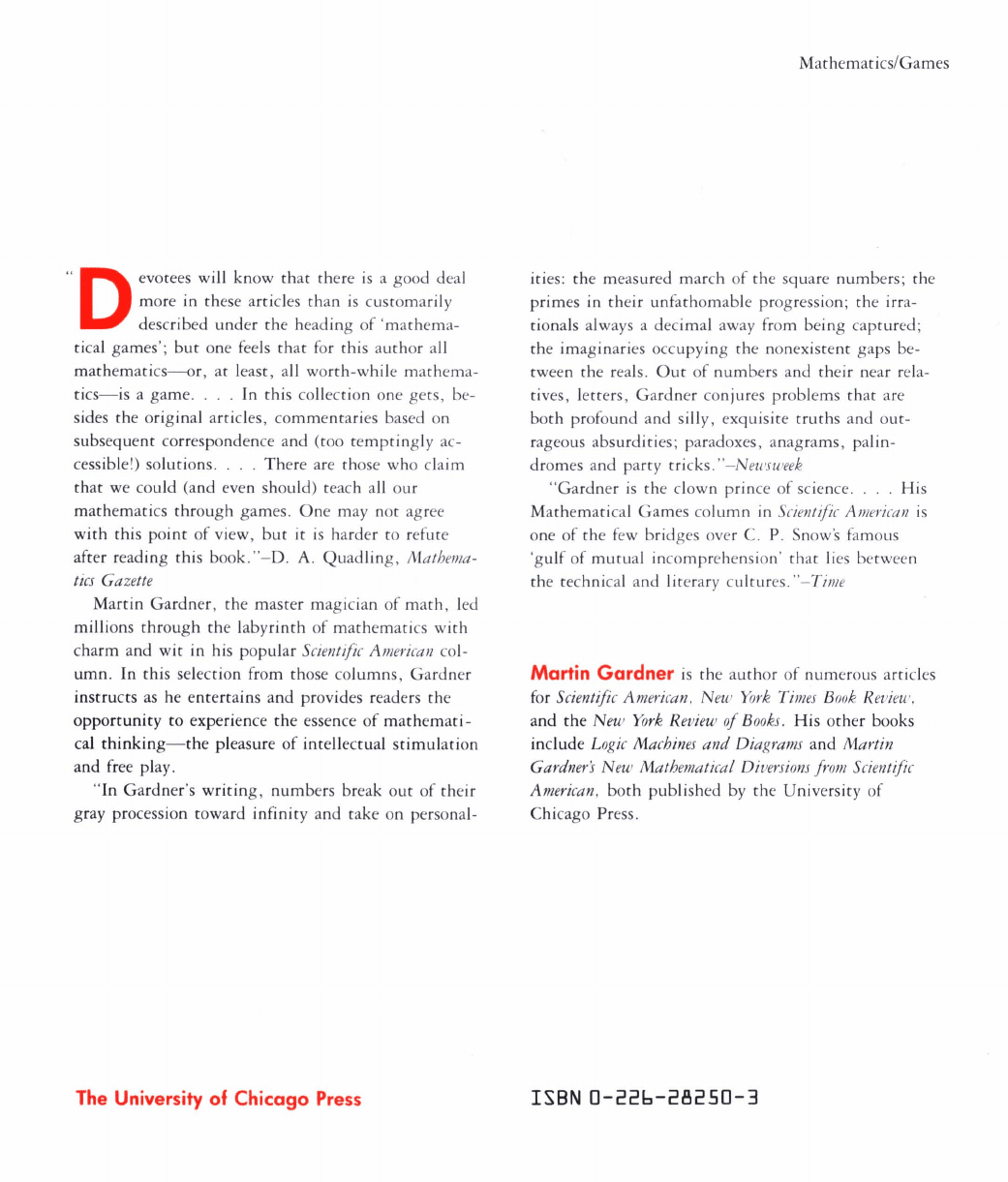
''
D
evotees will know that there is a good deal
more in these articles than is customarily
described under the heading of 'mathema-
tical games'; but one feels that for this author all
mathematics-r, at least, all worth-while mathema-
tics-is a game.
. .
.
In this collection one gets, be-
sides the original articles, commentaries based on
subsequent correspondence and (too temptingly ac-
cessible!) solutions.
.
. .
There are those who claim
that we could (and even should) teach all our
mathematics through games. One may not agree
with this point of view, but it is harder to refute
after reading this book."-D.
A.
Quadling,
Matbema-
tics Gazette
Martin Gardner, the master magician of math, led
millions through the labyrinth of mathematics with
charm and wit in his popular
Scientgic American
col-
umn. In this selection from those columns, Gardner
instructs
as
he entertains and provides readers the
opportunity to experience the essence of mathemati-
cal
thinking-the pleasure of intellectual stimulation
and free play.
"In Gardner's writing, numbers break out of their
gray procession toward infinity and take on
personal-
The University of Chicago Press
ities: the measured march of the square numbers; the
primes in their unfathomable progression; the irra-
tionals always a decimal away from being captured;
the imaginaries occupying the nonexistent gaps be-
tween the
reals. Out of numbers and their near rela-
tives, letters, Gardner conjures problems that are
both profound and silly, exquisite truths and out-
rageous absurdities; paradoxes, anagrams, palin-
dromes and party tricks.
"-Newsweek
"Gardner is the clown prince of science.
. . .
His
Mathematical Games column in
Scientific American
is
one of the few bridges over
C.
P.
Snow's famous
'gulf of mutual incomprehension' that lies between
the technical and literary cultures."-Time
Martin Gardner
is the author of numerous articles
for
Scientgic American, New York Times Book
Revzeul,
and the
New
York Review of Books.
His other books
include
Logic Machines and Diagrams
and
Martin
Gardneri- New Mathematical Diversions from Scientqic
American,
both published by the University of
Chicago Press.
